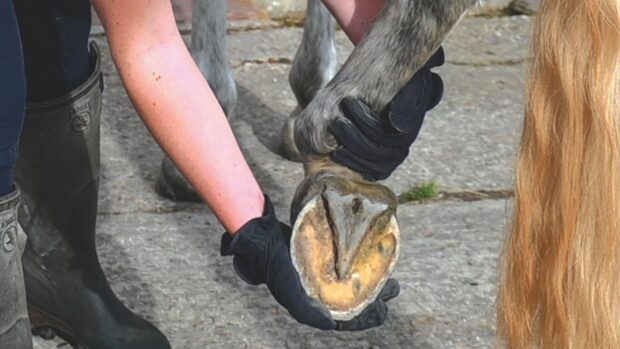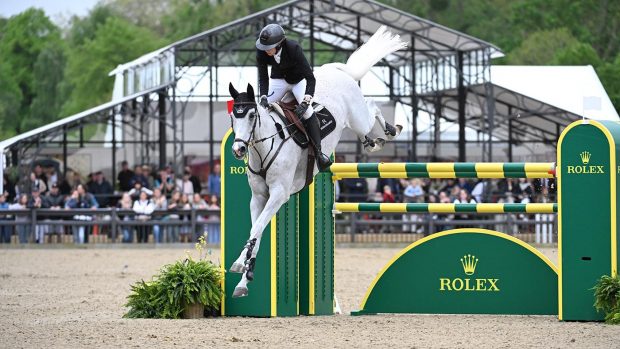Standard horseshoes are made from steel and are concave. This elevates the frog, leaving the heels with more weight to carry. Strong-footed horses can cope with this, but weaker-footed ones run into problems, no matter how well they are shod.
Horses with weak flat feet and collapsed heels will benefit from a modified design of shoe, which enlarges the ground-bearing surface at the heels, such as an egg-bar and heart-bar shoe.
The unshod foot
The unshod foot bears most weight on the hoof wall and frog, with the sole bearing only minimal weight. The frog has a largearea of contact with the ground, giving the back of the foot a larger overall bearing surface than the toe area. The front of the foot tends to wear more than the heel area. The combination of a larger heel/ground surface and greater toe wear helps to maintain the normal axis..
Broad web shoes
On the continent, broad web shoes are worn as an everyday shoe. They are made of thinner steel, which allows the frog to make some ground contact and so carry some of the horse’s weight. Broad webbed shoes are fitted wider and longer at the heels than traditional shoes. The wider ground-bearing surface gives greater protection to the sole. Broad webbed shoes tend to provide less grip, which can help horses with concussion-related problems.
Aluminium broad web shoe
Aluminium is softer and lighter than steel. The softness provides grip on grassy surfaces, but wears down quickly on the roads. These shoes tend to be used on competition horses and provide a lightweight shoe with good grip, while providing all the benefits of the broad web shoe.
Racing plate
Racing plates are made from aluminium and are concave, which provides excellent grip qualities, but at the expense of life of the shoe.
Straight-bar shoe
This shoe has a bar that runs directly between the two heels, enlarging the ground-bearing surface at backof the foot. The widest part of the frog also bears some weight. A straight-bar shoe doesn’t protruding far behind the foot and is therefore less likely to be pulled off than an egg-bar shoe.
Egg-bar shoe
This is an oval shaped shoe and is usually used on horses with pre-navicular and navicular disease. The frog is not supported, as the bar extends behind it, which can be a problem when used with very flat feet, as the frog will “drop through” because it is unsupported. In this case, a heart-bar shoe may be better.
The shoe has a considerably enlarged heel-bearing surface and is usually applied to the front feet with a rolled toe. Recently, egg-bar shoes have been fitted to hind feet, as the extended heel surface gives support to horses with hock problems.
Heart-bar shoe
Heart-bar shoes can be used to help treat laminitis and flat feet. Applying them requires great accuracy and an in-depth understanding of the equine foot, particularly the processes taking place within a foot affected by acute laminitis. More recently, heart-bar shoes have been applied to flat feet. The shoe mimics the unshod foot, as the frog and wall are restored to a natural pattern of weight bearing.
Lateral and medial extension shoes
Primarily used on foals or young stock with limb development problems, these shoes extend to the inside (medial) or the outside (lateral). By creating a ground-bearing surface in the position where the foot should be, the active growth plates can adapt to the foot’s modified posture. The plates must be actively growing, as you cannot change the posture of a foot once the limb has stopped growing.
Read more about shoeing:



